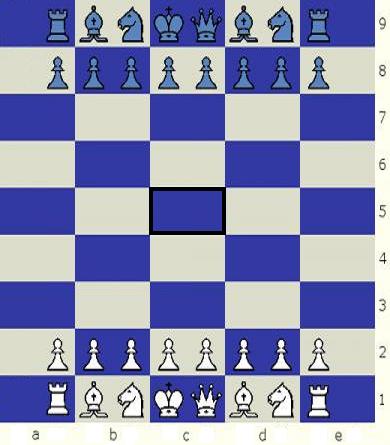Corral Chess
Corral Chess is an entry in the 45 or 46 Cell Contest. Perhaps I'm taking the contest theme a bit too literally, since it is debatable whether this variant has 45 or 46 squares.
The rules for FIDE chess apply except as contradicted below.
Setup
The board has two levels. The main level has nine rows and five columns and the bottom level consists of a single square (the "prison") immediately below c5. White starts with eight Pawns (two each on b2,c2,and d2, and one each on a2 and e2), two Rooks (a1 and e1), two Knights (b2 and d2), two Bishops (b2 and d2 again), a Queen (c2), and a King (c2 again). Black has a symmetrical set of pieces on its side of the board.
Below is a picture of the main level. The unpictured prison is directly behind the square with the black border.

Pieces
The Pawn moves like a FIDE Pawn, except that promotion occurs on the ninth rank rather than the eighth. (Yes, these Pawns can capture en passant.)
The Rook is a 4-Rook, able to move no more than four squares in a horizontal or vertical direction. (If I didn't shorten the Rook's range, the Bishops would be at a severe disadvantage due to the shape of the board.)
The Knight moves like a FIDE Knight.
The Bishop is a 4-Bishop, able to move no more than four squares in a diagonal direction (due, of course, to the shape of the board).
The Queen is a 4-Queen, able to move as a 4-Bishop or a 4-Rook.
The King moves like a FIDE King, and has the additional power to move from c5 into the prison. However, a player moving the King into the prison has lost the game.
Rules
- The object of the game is to force the opponent's King into the prison. Checkmates are illegal.
- (As you may have gathered from the setup,) Two or more friendly pieces may occupy the same square. A piece may move to a square already occupied by one or more friendly pieces. However, only a Knight (or a piece being carried by a Knight -- see rule 4 below --) may jump over occupied squares.
- If a piece lands on a square occupied by one or more of the opponent's pieces, all of the opponent's pieces on that square are captured.
- If a piece moves from a square with additional friendly pieces, it may take some or all of those friendly pieces to its destination square, unless doing so would put the King in check.
Notes
Rewriting the rules so that there are only 45 squares is easy. (e.g., instead of a prison cell, we say instead that checkmate can occur only on c5.)
 This 'user submitted' page is a collaboration between the posting user and the Chess Variant Pages. Registered contributors to the Chess Variant Pages have the ability to post their own works, subject to review and editing by the Chess Variant Pages Editorial Staff.
This 'user submitted' page is a collaboration between the posting user and the Chess Variant Pages. Registered contributors to the Chess Variant Pages have the ability to post their own works, subject to review and editing by the Chess Variant Pages Editorial Staff.
By Doug Chatham.
Web page created: 2007-09-07. Web page last updated: 2007-09-07